Mushrooms
Media
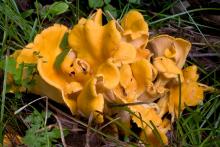
Species Types
Scientific Name
Cantharellaceae (various members of family)
Description
Chanterelles are funnel- or trumpet-shaped and have wavy cap edges. Most are bright orange or yellow, although one, the black trumpet, is brownish black.
Media

Species Types
Scientific Name
Coprinellus micaceus (formerly Coprinus micaceus)
Description
The mica cap has a bell-shaped, tawny brown, radially lined cap and inky gills. It grows in clusters around stumps or on wood debris.
Media
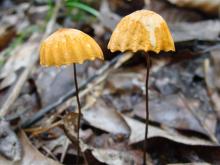
Species Types
Scientific Name
Marasmius siccus
Description
The orange pinwheel marasmius is a tiny mushroom with an orange, bell-shaped, pleated cap, white gills, and a skinny brownish stalk. It grows scattered to many on dead leaves, wood, and twigs of deciduous trees.
Media

Species Types
Scientific Name
Galiella rufa (formerly Bulgaria rufa)
Description
The hairy rubber cup has a reddish to brownish inner surface; the outside is blackish brown and hairy. It grows in clusters on dead deciduous wood.
Media
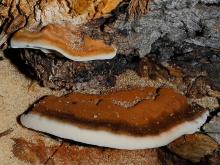
Species Types
Scientific Name
Ischnoderma resinosum
Description
The resinous polypore is a large, thick, velvety, brownish bracket fungus with a thick margin and whitish pores. It grows on logs and stumps of deciduous trees.
Media
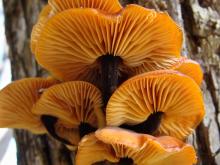
Species Types
Scientific Name
Flammulina velutipes
Description
The velvet foot, or enoki, has a tawny, sticky cap with whitish gills. The stalk is yellowish above and brownish below. They grow in clusters on deciduous logs.
Media
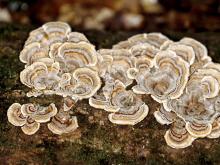
Species Types
Scientific Name
Trametes versicolor
Description
Turkey tail grows in clusters of leathery, thin brackets with multicolored zones above and whitish yellow pores below. Look for it on stumps and logs of deciduous trees.
Media

Species Types
Scientific Name
Trichaptum biforme
Description
The violet toothed polypore is a bracket fungus with tough, hairy caps with violet margins and zones of white, brown, and black; beneath, the whitish violet pores break into teeth. It grows on stumps and logs of deciduous wood.
Media

Species Types
Scientific Name
Polyporus badius
Description
The black-footed polypore has a smooth, wavy brown cap with whitish or tannish pores on the underside and a black, smooth, off-center stalk. It grows singly or in groups of up to several on dead wood and stumps of deciduous trees.
Media
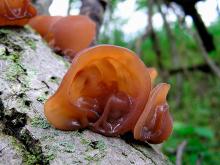
Species Types
Scientific Name
Auricularia auricula (formerly A. auricula-judae)
Description
The wood ear is a reddish brown to grayish black, rubbery, earlike or cup-shaped mushroom. It usually grows in groups on rotting wood.
See Also



Media

Species Types
Scientific Name
Monotropa hypopitys
Description
Pinesap is a plant that puts the "wild" in wildflower! It lacks chlorophyll, so its roots connect to fungi underground and absorb nutrients from the fungi.
Media

Species Types
Scientific Name
Cladophora, Pithophora, and Spirogyra spp., and others
Description
Filamentous green algae forms green, cottony masses that are free-floating or attached to rocks, debris, or other plants.
Media

Species Types
Scientific Name
Monotropa uniflora
Description
Indian pipe lacks chlorophyll, so it is white, not green. Below ground, its roots join with fungi that connect to tree roots. This plant, then, takes nourishment indirectly from the trees.
About Mushrooms in Missouri
Mushrooms are a lot like plants, but they lack chlorophyll and have to take nutrients from other materials. Mushrooms are neither plants nor animals. They are in a different kingdom — the fungi. Fungi include the familiar mushroom-forming species, plus the yeasts, molds, smuts, and rusts.
Always be cautious when eating edible mushrooms. Be absolutely sure of the ID, and only eat a small amount the first time you try it to avoid a reaction..





















